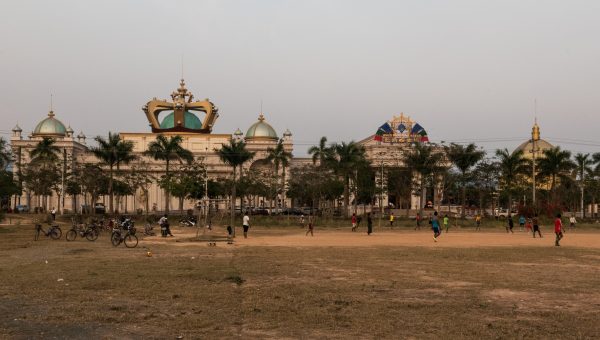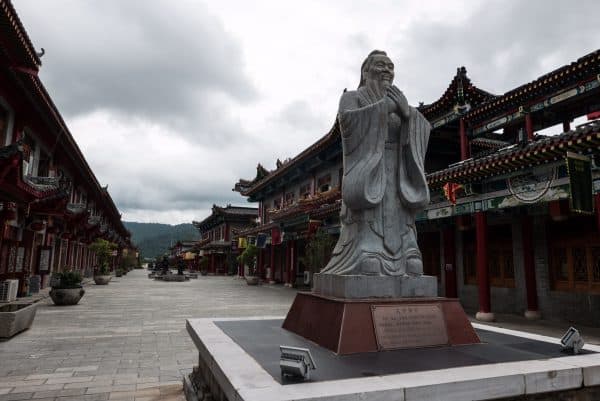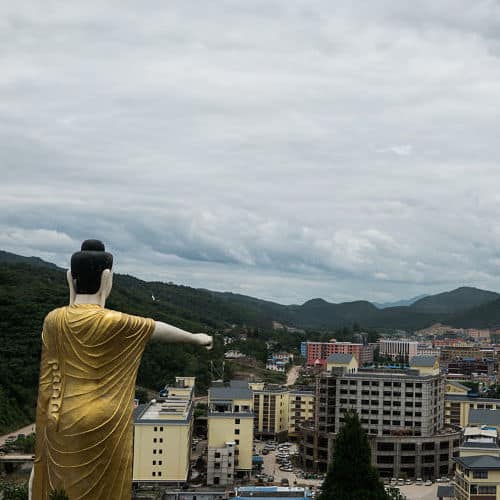The forested hills where Myanmar, Laos, Thailand and China meet are commonly known as the Golden Triangle, the world’s second largest opium-producing area. A common narrative when it comes to those secluded borderlands is that of lawlessness, danger, and perversion. This characterisation seems reinvigorated today by the existence of two casino-towns: Mong La in Myanmar, and the Golden Triangle Special Economic Zone in Laos, both (in)famous for their role in drug and human trafficking, as well as in money laundering and wildlife trade. In recent reportages, for instance, the BBC called Mong La “Myanmar’s lawless region where anything goes”, and Time defined it as “the ultimate oasis of sin”.

Then there is another narrative, a more academic one, which goes back to the historian Willem van Schendel’s definition of ‘Zomia’. With this geographical label, van Schendel proposed to consider the highlands of Southeast Asia as a political and historical entity significantly distinct from the usual divisions of area studies, an idea that was later famously developed by James Scott in The Art of Not Being Governed. For Scott the central issue is arguably not ‘Zomia’ as a delimited geographical unit, but rather Zomia as a state of mind and a mode of behaving. Particularly, Scott’s argument is that the Zomia region until recent times was one of the last zones of escape – an area to which people moved to in order to avoid incorporation into states. Thus, a significant part of the Zomian population consisted of people who chose not to be part of a state and who acquired cultural inventories that were appropriate to this goal: forms of agriculture compatible with frequent movement, the ability to shift between multiple ethnic identities, non-hierarchical religious systems, and so on. According to Scott’s analysis, Zomia and other similar escape zones have by now effectively been incorporated into nation-states, thanks in particular to what he calls “distance-demolishing technologies”, such as railways, all-weather roads, and telecommunication.

However, my argument here is that Mong La and the Golden Triangle SEZ are not – as the lawlessness narrative seems to imply – the last remains of Scott’s Zomia; rather, they represent a different attempt to reach the same goal: escape state power.
A new Zomia – a Zomia 2.0 – that is characterised as much by political remoteness as by neoliberal connectivity.
Mong La is the largest town in the small autonomous strip of land on the Chinese border formally known in Myanmar as Special Region 4, created in a ceasefire agreement with the Myanmar government in 1989. Special Region 4 has ever since been governed by a Shan-Chinese named Lin Mingxian. Initially built on drug money, several casinos appeared in Mong La in the 1990s. As a result of two Chinese crackdowns in the early 2000s, Lin invested into the growing online gambling industry. Soon he began to build new casino facilities ten miles south of town, where they can be found today, bustling with Chinese costumers.
Beside Lin Mingxian several other Chinese have invested in Mong La’s casinos. Zhao Wei, a businessman from northern China, opened a casino in Mong La in 2000 and later exported the Mong La model to Laos, where he established his own Kings Romans casino in the Golden Triangle SEZ, an area that he leased from the Laos government for 99 years. Like Mong La, the Laos SEZ was built for Chinese gamblers and tourists; accordingly, Chinese currency, language and phone networks are widely used.
Both Lin and Zhao, moreover, seem to spend great effort mimicking state practices and aesthetics, relying on their own bureaucracy and police force dressed in uniforms that look very much like the ones of their Chinese peers. Thus, the so-called casino-towns in Myanmar and Laos are not just private enterprises based on the profits of gambling, but modest attempts at state-making, or at least ‘state mimicking’, as anthropologist Pal Nyiri puts it.
In the 21st century, I argue, the best (or, perhaps, the only possible) way to keep the state out is to let it in – through investments, infrastructures, and deals with officials and governments on all sides. However, this “bringing the state in” occurs in terms of exceptionality, which means that the state “gives up” its regulatory power in exchange for formal recognition, infrastructure development, and the possibility – for those in power – to accumulate hidden fortunes. It is through the ambiguous presence of the state that these spaces manage to maintain a unique level of autonomy within the modern nation-state system.
Or, to put it in other words, it is by making themselves “legible” to state authorities, on the surface at least, that Mong La and the Golden Triangle SEZ can remain largely outside of the regulatory power of the state.
Moreover, as the cases of the Kachin Independent Army and the United Wa State Army show, while in the highlands of Asia it is still possible to evade the state, it has become utterly impossible to do so without coming to terms with a growing and increasingly influential Chinese presence. To be sure, if we look at the aforementioned armed groups in northern Myanmar, they both would not last long without some kind of support by China – with regard to both government support and access to the Chinese market. Zomia 2.0 thus refers to the fact that Mong La and the Golden Triangle SEZ might not necessarily represent an attempt to escape the state in Scott’s sense, but certainly represent an attempt to deal with China on the best possible terms: a “China effect” rather than a “state effect”.

The main difference with Scott’s argument, and the reason this is a story of neoliberal connectivity, is that both Mong La and the Golden Triangle SEZ are elite projects. Unlike Scott’s Zomian societies, there is no sense of egalitarian community. Rather, we find an enterprise envisioned and carefully implemented by powerful elites. As is increasingly the case elsewhere, here only elites can afford real mobility and exceptionality. The profit-driven system in place even seems to reinforce economic inequality and the marginalisation of local groups. Casino employees, construction workers and the labour force on the local plantations are disposable and easily replaceable. Zomia 2.0 is, at its very core, a project of and for profit-oriented and ideology-free elites.
To conclude: what does this tell us about remoteness, or the return of remoteness? Mong La and the Golden Triangle SEZ have formally achieved some form of autonomy from state rule. By mimicking state practices, and through careful cultivation of relations with state and non-state actors in the area, they are able to generate licit profit through illicit means. By bringing the state in, and thus achieving formal recognition, they are able to keep its regulatory power out. These are, then, stories of political remoteness. But they are also stories of neoliberal connectivity, based on global investments, satellite phones, online gambling, and Russian croupiers to project a more trustworthy and international image. Today, these two things, here as elsewhere, are inseparable, and I believe this is how the “return” of remoteness should be analysed. As in:
What happens in remote areas has a global impact, precisely because the very existence of those areas relies on global connections.
Bilbiography
Nyiri, Pal. 2012. “Enclaves of Improvement: Sovereignty and Developmentalism in the Special Zones of the China-Lao Borderlands.” Comparative Studies in Society and History 54 (03): 533–62.
Scott, James C. 2009. The Art of Not Being Governed: An Anarchist History of Upland Southeast Asia. New Haven: Yale University Press.
van Schendel, Willem. 2002. Geographies of Knowing, Geographies of Ignorance: Jumping Scale in Southeast Asia. Environment and Planning D: Society and Space 20: 647-668.






The idea of Zomia 2.0 works quite well, I think. I appreciate the (IMHO correct) rendering of Scott being interested in a model more than a comprehensive historical reconstruction. One can easily see how certain practices can be “escape 2.0”, regarding the economy, mobility, documentation, etc. – all to escape state power, or at least to be able to deal with state power on one’s own terms.
Two question/comments:
– an important feature of Zomia was its “shatter zone” aspect: a disaggregation leading to numerous small polities. Is there any analogue to this here?
– I am not finally convinced that we can already dismiss egalitarianism just because “elites” enter the picture. Is there not maybe some sort of “elite egalitarianism”, in that these “ideology-free” people come together to carefully curate these places while making sure that no single member of this class becomes king? Are they not metaphorical brothers in illicit arms/drugs/riches? I think if we restrict “egalitarianism” to the poor and “1.0” people of the world, we might be missing out on something. (While, admittedly, elites are notoriously opaque, especially such shady types, and it might be really hard to tell what is going on among them.)